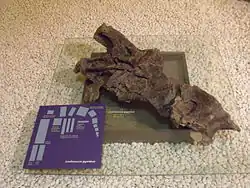Losillasaurus
Losillasaurus (meaning "Losilla lizard") is a genus of sauropod dinosaur from the Late Jurassic and possibly Early Cretaceous (Kimmeridgian-?Berriasian) in the southeast of Spain. The type species of the turiasaurian Losillasaurus giganteus was discovered in the Villar del Arzobispo Formation and later the Praia de Amoreira-Porto Novo Formation (subunit of the Lourinhã Formation) in Valencia and formally described by Casanovas, Santafé and Sanz in 2001. The holotype material is from a subadult and includes part of a skull; complete cervical, dorsal, sacral, and caudal vertebrae as well as several fragments; skeletal elements from the limbs including a humerus, ulna, radius, and metacarpal; sternal plates; and from the pelvis: the ilium, ischium, and pubis. The genus is characterized by the dimension and shape of the neural spine of the proximal caudal vertebrae.[1][2] The humerus is 143 centimetres (56 in) long,[3] which despite being from a subadult specimen is within 20% of the size of Paralititan.[4] The size estimation proposed by Francisco Gascó in his master thesis is 15–18 m (49–59 ft) and 12-15 tons.[5]
| Losillasaurus | |
|---|---|
 | |
| L. giganteus vertebra | |
| Scientific classification | |
| Kingdom: | |
| Phylum: | |
| Class: | |
| Superorder: | |
| Order: | |
| Infraorder: | |
| (unranked): | |
| Genus: | †Losillasaurus Casanovas et al., 2001 |
| Binomial name | |
| †Losillasaurus giganteus Casanovas et al., 2001 | |
Description
Several specimens of L. gianteus were described in 2019 and 2020 - one such specimen (SNH 180) consists of a single anterior caudal vertebra, while another (the holotype) consists of a partial skull with teeth and partial postcranial skeleton.[6] According to Rafael Royo-Torres et al., the specimen helps scientists to understand tooth variation, allows the positioning of isolated heart-shaped teeth in the skull and demonstrates heterodonty in Turiasauria.[7]
References
- Casanovas, Maria Lourdes; Santafé, José Vicente; Sanz, José Luis (2001). "Losillasaurus giganteus, un nuevo saurópodo del tránsito Jurásico-Cretácico e la Cuenca de "Los Serranos" (Valencia, España)". Paleontologia i Evolució (in Spanish). 32–33: 99–122.
- Ruiz-Omeñaca, Jose Ignacio (2001). "Losillasaurus giganteus, a new Spanish sauropod". Dinosaur Mailing List.
- Ruiz-Omeñaca, Jose Ignacio (2001)."Re: Losillasaurus giganteus, a new Spanish sauropod". Dinosaur Mailing List.
- Taylor, Mike (2001). "Re: Losillasaurus giganteus, a new Spanish sauropod". Dinosaur Mailing List
- Gascó, F (2009): Sistemática y anatomía funcional de Losillasaurus giganteus Casanovas, Santafé & Sanz, 2001 (Turiasauria, Sauropoda). Universidad Autónoma de Madrid.
- Campos-Soto S, Benito MI, Cobos A, Caus E, Quijada IE, Suarez-Gonzalez P, Mas R, Royo-Torres R, Alcalá L. 2019. Revisiting the age and palaeoenvironments of the Upper Jurassic–Lower Cretaceous? Dinosaur-bearing sedimentary record of eastern Spain: implications for Iberian palaeogeography. Journal of Iberian Geology 45: 471–510.
- Rafael Royo-Torres; Alberto Cobos; Pedro Mocho; Luis Alcalá (2020). "Origin and evolution of turiasaur dinosaurs set by means of a new 'rosetta' specimen from Spain". Zoological Journal of the Linnean Society. Online edition. doi:10.1093/zoolinnean/zlaa091.












